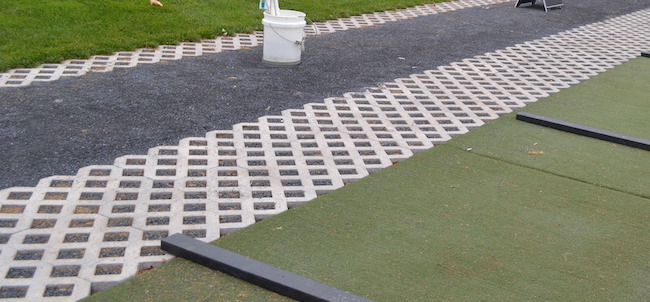
1. Excavate and compact the soil sub-grade.
2. Place and compact the gravel base (Figure 1). The gravel base should extend beyond the Turfstones a min. of 6? where possible. For residential use, 6 in. base is recommended. For vehicle loads and traffic, a minimum of 8 in. Use filter cloth for low CBR soils (less than 4%), those with high clay and silt contents, soils in high water table areas, or soils in low lying areas subject to flooding. Cloth should be fine enough to prevent migration of soil into the base. Woven fabrics are preferred over non-woven materials when the cloth is placed directly under the sand layer where subjected to traffic.
3. Spread and screed the bedding sand (grading to conform to ASTM C33). Do not use masonry sand. Sand should be screeded to proper elevations and have uniform moisture content prior to placing the Turfstone pavers. The screeded sand should not be disturbed.
4. Place the Turfstones on bedding sand. Turfstones should be placed with the minimum joint spacing of at least 1/16?.
5. Vibrate the Turfstones into the sand. Use a high-frequency (3500-5000 cycles per second), low amplitude plate vibrator. A rubber mat should be attached to the vibrator to protect the grids from cracking and chipping. Plywood sheets placed on the Turfstones can be used for protection if a rubber mat is not available.
6. Spread topsoil or gravel into the Turfstones and vibrate again. Grass seed and fertilizer can be mixed with the topsoil or broadcast directly on the surface and swept into openings and joints.
7. Vibrate again after voids are full. The final level of topsoil should be 1/2? to 3/4? below the top surface. This will lend some protection to the grass from tires as it grows.
